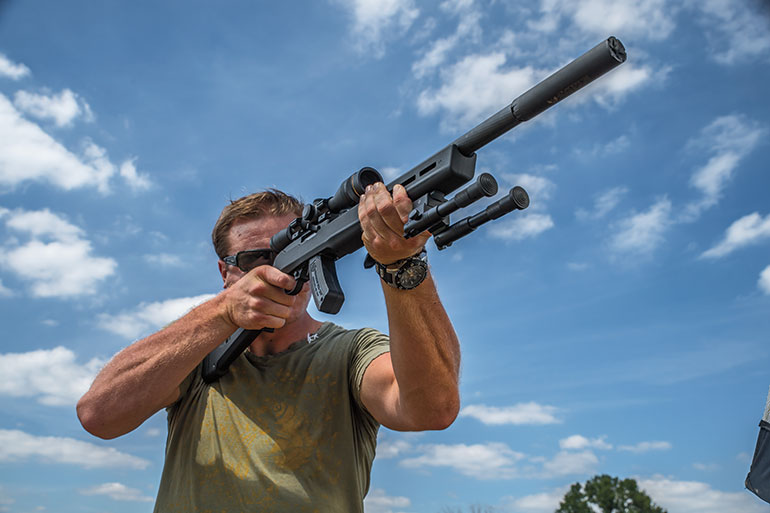My first introduction to suppressed firearms began nearly a decade ago when I was handed a Heckler & Koch (HK) MP5 Navy with a Knight’s Armament suppressor. The suppressor nearly doubled the length of the firearm and made it infamously dirty and difficult to clean. But to me, a brand-new SWAT cop, it was literally cooler than The Fonz punching the jukebox to play his favorite tune, as all the girls from Arnold’s came running. Suppressor technology has come light years since my beloved hand-me-down MP, in terms of size, material, impact shift and sound suppression, but one thing that hasn’t changed is the emotion stirred when you pick one up and crank it down on your gun.
Most people’s first experience with suppressors is not as business-oriented as mine. A lot of people get into suppressed firearms as a progression. They become interested in shooting, discover how fun it is, and the obsession evolves from there. The .22 LR suppressors are a great gateway from shooting unsuppressed to the high-dollar big boys. I warn you, however, that this is not just a review but also a cautionary tale. Once you start shooting suppressed, it’s addictive.
SURVEY
Help the Firearm Industry Better Serve You
Please assist hunting and shooting sports companies serve firearms owners with better products and services by taking several minutes to complete an anonymous survey by Southwick Associates. All survey responses are fully confidential.
TAKE THE SURVEY
Weighing Options
With so many options on the market, how do you decide which suppressor is right for you? Let’s be honest, this is a major purchase. Between the cost of the suppressor, the cost of the National Firearms Act (NFA) stamp and the waiting period, you have a lot invested in a suppressor by the time you actually take possession. The last thing you want is the excitement of your long-anticipated purchase destroyed on the first range trip because it won’t group, isn’t quiet, won’t allow the gun to cycle or anything else on the list of things that can ruin an experience. There are many factors incorporated into a quality suppressor. It can be overwhelming: accuracy, point of impact (POI) shift, decibel reduction, weight, length, materials used and so on. You can’t take them on a test drive, with NFA and all, so I selected four of the most popular .22 LR cans and ran them head-to-head – same rifle, same sound equipment, same ammunition.
Advertisement
Test Rifle
A Ruger 10/22 Tactical was my choice. It featured a heavy barrel, nestled down into a Magpul stock and a Leupold VX-2 3-9x33mm Rimfire EFR scope bolted on top. The barrel was threaded to the standard 1/2×28. This is the same thread size of all the suppressors tested. To keep things consistent, ELEY subsonic hollow ammunition was used for all testing. This ensured continuity for accuracy, POI shift, decibel reduction and cycling when changing from one suppressor to the next. The rifle and ammo combination was a delight to shoot; I could have blasted away all day without suffering from fatigue or boredom. It was particularly fun once the accuracy testing was complete, and I began punishing the steel lined up along the backstop. I can’t think of a more enjoyable way to spend a Sunday afternoon in August.
Advertisement
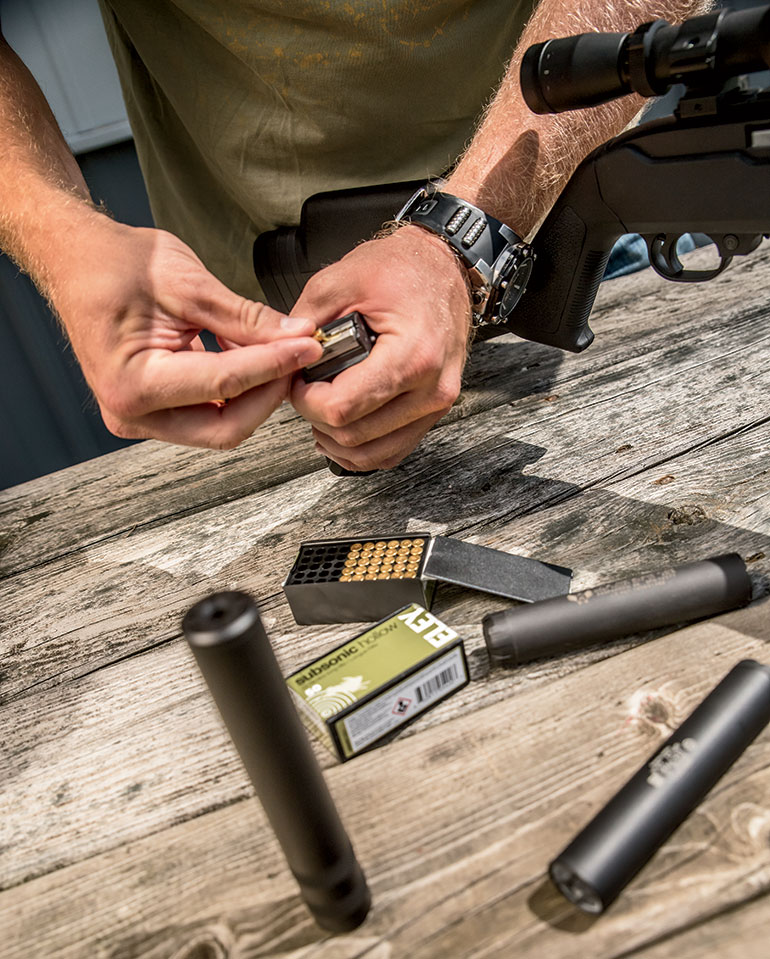
The Ruger/ELEY combination proved to be a great match in terms of accuracy and cycling. The platform operated flawlessly, both unsuppressed and suppressed, and churned out some impressive groups, with a best of .24 inch (four-shot group) with the SilencerCo Sparrow 22, if you throw out a flier (more on that later). For a gun you can purchase and take straight to the range for around $500, that’s not too shabby. All accuracy testing was done off a bench at 50 yards, utilizing a bipod mounted to the Magpul stock.

Test Candidates and Methods
The four suppressors in the lineup were the Gemtech GM-22, Elite Iron Echo Lite 22LR, Dead Air Armament Mask and SilencerCo Sparrow 22. I conducted three, five-shot groups with each can. The rifle without a suppressor averaged 134.6 decibels (dB). Then I shot three, five-shot groups suppressed for all of the cans tested. All of the suppressors were direct-thread attachment. To see if there was any variance when taking them off and putting them back on, all suppressors were completely removed and threaded back on between groups two and three. When taking the suppressor off between the second and third groups, I was careful to start threading on the suppressor with it indexed in a different position. The idea was to determine how much impact shift, if any, we can expect when switching from suppressed to unsuppressed, or if we need to sight in the gun again if the suppressor is removed for cleaning or another purpose.
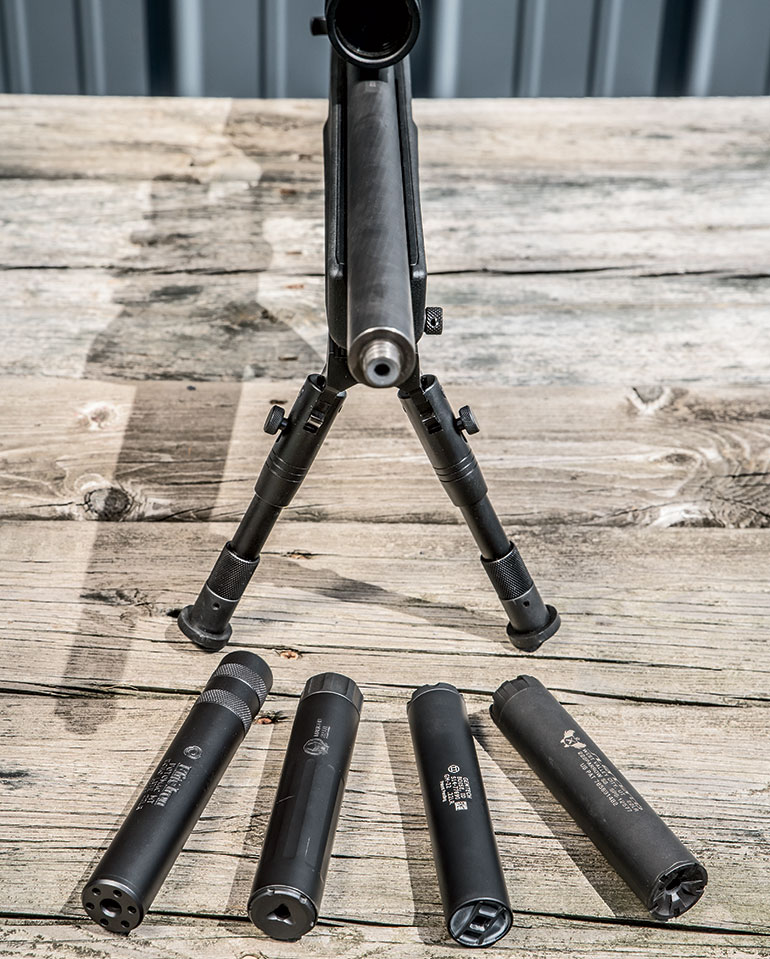
Sound testing was conducted utilizing Larson Davis sound equipment, which was calibrated prior to testing. The weather was 74 degrees and sunny with 57 percent humidity. Testing was done with the microphone next to the shooter’s ear, as that is how it affects the majority of shooters. Ensuring the end user has a clear picture of the bang they are getting for their buck is, after all, the end goal.
Gemtech GM-22
The Gemtech GM-22 was the first suppressor I tested. Taking it out of the box, the GM-22 was significantly lighter than the other three, coming in at only 2½ ounces. It is constructed of 7075 aluminum with a titanium-thread insert, is 5 inches long with a 1-inch diameter and is finished with a matte-black Cerakote. The GM-22 is rated for multiple calibers – .22 LR, .22 WMR and .17 HMR – and automatic fire in .22 LR. Gemtech notes that it is not rated for .17 WSM. Included in the box were a well-constructed, coyote-colored pouch with MOLLE attachment and a disassembly tool. While the GM-22 was a nicely finished product on the outside, I couldn’t understand what was inside to produce with such form. The Ruger averaged .83 inch without a suppressor; those groups opened up to a 2.11-inch average, with a best of 2.02 inches, with the GM-22 screwed on. The point of impact also shifted by an average of 5.51 inches. On the third group, after taking the suppressor off and putting it back on, I got the greatest point of impact shift of 8.3 inches. If you wanted to use this suppressor, it would have to be on a designated firearm, and then you’d have to find an ammo it liked. The combination would have to be taken to the range and re-?zeroed every time the suppressor was removed for cleaning as well.
The GM-22 was lacking in point of aim, point of impact shift and accuracy, but it certainly held its own in the area of sound suppression. The average decibel level from the five-shot group with the GM-22 was 122.4 dB. That’s a 12.2 dB reduction at the shooter’s ear from the unsuppressed firearm, placing it in a respectable third amongst the suppressors tested. It fell short of second place (SilencerCo) by just .04 dB. Gemtech’s GM-22 also gets honorable mention after coming in with the lowest decibel level recorded, a whispering 117.9. To put that in perspective, the gun averaged 118.64 dB when we simply cycled the action by hand.
Gemtech GM-22 Specs
- Materials: 7075 aluminum
- Cartridge: .22 LR, .22 WMR, .17 HMR
- Overall Length: 5 in.
- Weight: 2.5 oz.
- Diameter: 1 in.
- Noise Reduction: 36–39 dB
- Attachment Type: Thread on
- Finish: Matte-black Cerakote
- MSRP: $400
- Manufacturer: Gemtech
Elite Iron Echo Lite
Next, I went to the Elite Iron Echo Lite. This was my favorite design. The great thing about .22 LR suppressors is that they come apart so you can clean them; the worst thing about .22 LR suppressors is they come apart when you try to take them off the firearm. Elite Iron figured out a simple but brilliant solution to this nuisance by making the end of the suppressor that attaches to the firearm sealed – it doesn’t come off. To disassemble the Echo Lite, you simply unscrew the removable end cap and hook the guts with a J-shaped tool to pull them out. The Echo Lite is 6 inches long has a 1-inch diameter and tips the scales as the heavyweight of the four at 10 ounces, which still isn’t going to break your back or require Popeye’s forearms to manipulate. It is constructed of all stainless steel with a subtle, matte finish. Included with the suppressor is a takedown tool for disassembly. Elite Iron states that the Echo is rated for automatic fire in .22 LR and is sturdy enough for semiautomatic fire in both .22 LR and .22 Mag.
I was pleased to see a significant difference in the results with the Elite Iron Echo on the range. The Echo only slightly opened up groups on the Ruger from .83 inch naked to an average of 1.32 inches with the suppressor on. It produced a best group of 1.12 inches. I was also pleased to discover that there was absolutely no shift in point of aim/impact going from unsuppressed to suppressed. This is an important issue for me. I don’t like having to make sight adjustments or to re-zero a firearm; it’s the same reason I don’t buy cheap optics. Having the ability to remove the suppressor and reinstall it without having to make a special trip to the range to sight it back in is a critical factor.
While accuracy and impact shift proved great with the Elite Iron Echo, it finished last in sound suppression, though not by a landslide. The Elite Iron Echo’s average for a five-shot group was 124.1 dB. This is only a 1.7-dB increase from the GM-22; the noise and tone was still quiet and far from uncomfortable. The noise reduction cost, in my opinion, is certainly worth the gain in terms of accuracy and aim/impact shift.
Elite Iron Echo Lite Specs
- Materials: Stainless steel
- Cartridge: .22 LR, .22 Mag
- Overall Length: 6 in.
- Weight: 10 oz.
- Diameter: 1 in.
- Noise Reduction: 33–37 dB
- Attachment Type: Thread on
- Finish: Matte
- MSRP: $400
- Manufacturer: EliteIron
Dead Air Armament Mask
Third in the lineup for noise reduction was the Dead Air Armament Mask. In terms of finish, this was the best-looking suppressor of the group. The Cerakoted, matte-black body was 5.1 inches long and 1.07 inches in diameter, weighing 6.6 ounces, and it comes with a disassembly tool. The body of the suppressor had louvers two-thirds of the way down, running the length of the suppressor, which added a nice visual appeal and broke up the cylindrical monotony of the standard look. The body of the Mask is constructed from a blend of titanium and 17-4 PH stainless steel. The Mask can be used in any caliber .17 to .22 LR and 5.7x28mm.
The Mask was also the easiest to take apart and put back together. You simply unscrew the ends, push out the guts and they spill out on the table in front of you. Getting things apart is easy, it’s putting them back together correctly that is the trick, right? Well, Dead Air thought of that, too. Apparently I’m not the only one who got frustrated with the “ready to assemble” furniture in college that came with inadequate instructions. Dead Air’s instructions were clear, and all the parts inside are notched, male/female, to avoid any mishaps. The only mistake I could foresee is that it is possible to attempt to put the baffles, as an assembled unit, in backward. But I tried that, and the Mask won’t go together that way. The end caps don’t line up, the spacing is off, and anyone with the slightest mechanical inclination should know something isn’t right. My only suggestion is to include a diagram labeling the parts of the suppressor – and this goes for all manufacturers, not just Dead Air. As I mentioned earlier, .22 LR suppressors are often an introduction to suppressors, and I learned as an instructor a long time ago that crystal-clear instructions are not helpful if your audience doesn’t have the vocabulary to keep up.
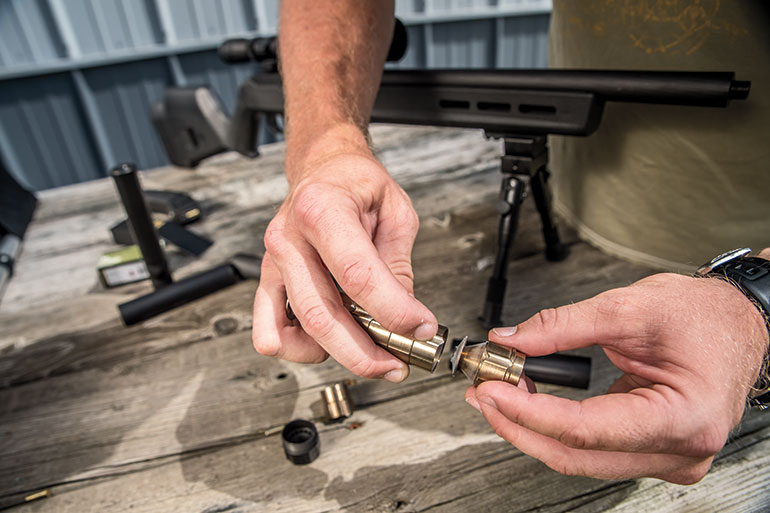
During the testing phase, the Mask marked a milestone where all the stars began to align and things got exciting. Up to this point, I had one suppressor that excelled at sound suppression, but struggled with accuracy and POI shift, and one suppressor whose accuracy was good, but wasn’t quite as good at decibel reduction. The Mask proved to be a triple threat, with increased accuracy, no POI shift and great decibel reduction. Not only did the Dead Air Mask sustain the accuracy of the Ruger, it actually improved the accuracy! With the Dead Air Mask threaded on the end of the Ruger, the group average went from .83 inch without a suppressor to .77 inch with the Mask installed, ringing in a best group of .57 inch. As with the Elite Iron Echo, there was no POI shift with the Dead Air Mask, even between the second and third groups when I removed the suppressor and reattached it.
The Dead Air Mask was also the quietest of the suppressors tested, beating the SilencerCo Sparrow 22 by just .60 dB. The Mask averaged a mere 121.7 dB, with one shot whispering into the mic at a fragile 118.4 dB!
Dead Air Armament Mask Specs
- Materials: Titanium, 17-4 PH stainless steel
- Cartridge: .17–.22 LR, 5.7x28mm
- Overall Length: 5.1 in.
- Weight: 6.6 oz
- Diameter: 1.07 in.
- Average Noise Rating: 121.7 dB (tested)
- Attachment Type: Thread on
- Finish: Cerakote
- MSRP: $450
- Manufacturer: Dead Air Armament
SilencerCo Sparrow 22
Last in the lineup was the SilencerCo. I have to admit, I didn’t expect much when I initially picked up the SilencerCo. They have a big name, and that typically makes me a bit gun-shy. But this ended up being my favorite. The Sparrow had the entire package – it’s the Justin Timberlake of .22 LRsuppressors. The SilencerCo Sparrow came to me in the ever-popular matte black, 5.08 inches long and 1.06 inches in diameter. The Sparrow is constructed of stainless steel and weighs 6.5 ounces. SilencerCo says it can handle automatic fire from a .22 LR and can also be used on an array of small-bore calibers, including .22 LR, .17 HMR, .22 MAG, .22 WMR, .22 Hornet and 5.7mm. Like all the others, the SilencerCo Sparrow was easy to disassemble and assemble. SilencerCo uses what they call Multi-Part Containment (MPC) technology in the construction of their Sparrow. MPC is a monolithic baffle system encased in two half tubes (think of the handguards on an M4), then the outer tube slides over the entire unit – a feature you’re sure to appreciate after blasting away all day on the range.
The Sparrow shrank the average group size out of the Ruger by almost half! It rang in an amazing .47-inch average, with the best group of the day coming in at just .39 inch.
I mentioned earlier that I would come back to fliers, and now the time has come. One thing I noticed while testing is that the first round of a shot group was always a bit outside the following four shots. I’m not a physicist, but I have two theories to account for this. The first is that the dynamic of the gun changes after the suppressor fills up with gas (after the first round) and shifts the impact ever so slightly. The other is that the heavy barrel of the Ruger, combined with the low temps of the .22 LR and the amount of time between shot groups, allowed the barrel to cool, producing a “cold bore” at the beginning of every group. Regardless of why it was happening, it was consistent. The reason I bring it up now is that if you throw out the flier of one of the groups of the Ruger with the Sparrow on it, the combination produced a .24-inch four-shot group! This happened on the last group, after removing the Sparrow and putting it back on.
The SilencerCo Sparrow held its own in decibel reduction as well, with a five-shot average of 122.3 dB. While the Dead Air Mask beat it out by a hair, you’d need a much better ear than mine to tell the difference of .60 dB. I would happily give up .60 dB of sound reduction for the confidence I gain in a weapon platform capable of averaging a .47-inch five-shot group, with no significant POI shift.
SilencerCo Sparrow 22 Specs
- Materials: Stainless Steel
- Cartridge: .22 LR, .17 HMR, .22 Mag., .22 WMR, .22 Hornet, 5.7mm
- Overall Length: 5.08 in.
- Weight: 6.5 oz
- Diameter: 1.06 in.
- Average Noise Rating: 112.7 dB–127.7 dB
- Attachment Type: Thread on
- Finish: Matte black
- MSRP: $540
- Manufacturer: SilencerCo
More Variables

We were having such a good time testing these suppressors on the Ruger 10/22, that one thing led to another and then another. The suppressed 10/22 was so quiet with the ELEY subsonic ammo that we began to wonder what the rifle would register on the sound equipment with a few variables. So here they are.
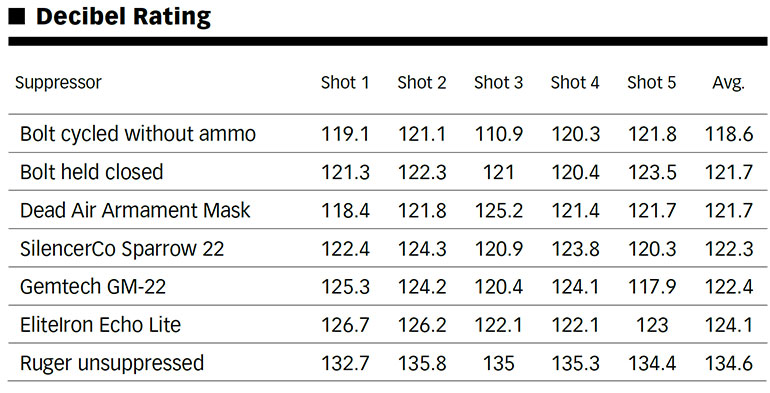
We first wondered how much of the sound we were picking up was from the bolt cycling. We shot a five-shot group using the Dead Air Mask while holding the bolt of the Ruger closed. This five-shot group averaged 121.7 dB. We then measured the cycling of the bolt without shooting the rifle. The result after five repetitions was an average of 118.6 dB. Stay with me here – if you take the average of all four suppressors combined, you get 122.6 dB. So the firearm is only 4 dB louder with bullets being fired out of it than it is being cycled without any bullets. This left me a bit flabbergasted. I’d say all four manufacturers have the sound-reduction game figured out.
Read the full article here


